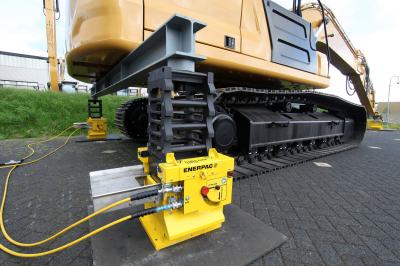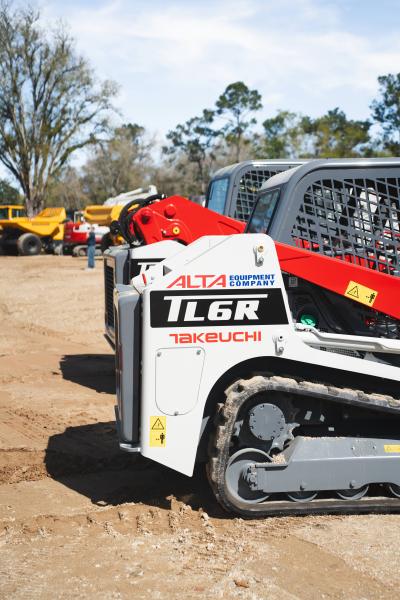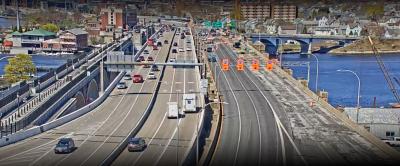Customers should expect to see wheel loader functions that help operators achieve the correct torque in all situations, maintain a steady throttle position and reduce wheel slippage, according to Eric Yeomans at Volvo.
It's blisteringly hot outside, dust and dirt is flying all around and noise is hammering your eardrums. Such is the environment at a typical construction site in the warmer months, particularly a big job requiring a lot of earthmoving; highway projects and manufacturing plants are perfect examples. In the winter, some work sites are set in below-zero temperatures where crews can be moving large rock or mining materials.
Whatever the time and place, construction machines that work efficiently, productively and afford their operators safe cabs from which to work is what all equipment manufacturers strive to produce.
A perfect example is the wheel loader — a staple of most construction jobs and materials yards. The loaders themselves range in size from large, 20-cu.-yd. buckets to small utility machines with the capacity of just a few cubic yards. Mostly, though, they are known for being able to lift and move practically anything: from asphalt to dirt to snow to logs, before moving them onto trucks, railroad cars, excavation pits or conveyor belts.
Design Tweaks Are the Norm
Wheel loaders utilize a basic design that hasn't changed much in decades. They sport a wide bucket connected to the end of two loader arms that are operated hydraulically. Buckets can be removed and replaced by attachments or tools to perform even more functions.
What does change about wheel loaders is that, over time, incremental design improvements are made by their makers. Those advances are made to, among other things, increase the machines' fuel efficiency and extend their service intervals, enhance their operator ease-of-use and safety and provide features that offer faster cycle times. To accomplish that, engineers are constantly working to develop and enhance new engine and transmission technology.
“Whenever companies make changes to their engines they always take that opportunity to also introduce new features and improvements to their OEM products,” noted Hugo Chang, wheel loader and compact products manager of LiuGong North America. “For instance, when we brought out our new Tier IV models about two years ago, we also increased the rated payload of the machine without changing much in the way of its physical appearance or the engine horsepower. It was done by a slight tweaking of the Z-bar linkage.”
After speaking with experts and designers at several wheel loader manufacturing companies, a range of opinions emerged about just how this basic — but vital — piece of machinery will continue to evolve in the coming years.
Value and Performance Wanted
Every advance in a wheel loader's technology or design is also made after its makers spend a lot of time learning just what equipment dealers and end-users want from the machines. That feedback often leads to a delicate balancing act for equipment makers: producing a technically-sound wheel loader at an attractive price.
“Manufacturers are trying to steer their wheel loaders toward better performance for the value,” described Brad Stemper, wheel loader product manager at Case Construction Equipment, “either for more productivity for that gallon of fuel that operators are using or for longer work days and safer operation. That also translates into the maintenance and long-term service of the product.
“The rule of thumb is that we are always working on the efficiencies for the operator and the fleet manager of the machines. That also means continually working on improving the powertrain systems and the hydraulic and cooling systems. As an industry, we constantly evaluate how we can improve these systems and make wheel loader use a better experience for the operator.”
As wheel loaders are a very mature product, many new improvements tweak the way the basic structure performs.
Evolving products such as telematics are cited by most experts as the leading new technology; others point to developments that will one day soon transform these diesel-powered workhorses into hybrid-fueled machines.
“I see the trend in the industry as moving toward alternative-energy sources and technologies, similar to the automotive industry,” said Craig McGinnis, Komatsu America's wheel loaders product marketing manager. “Every generation improves, meaning dealers and customers can look forward to increasing amounts of technology on their machines to add new levels of automation and control that improve machine productivity and performance.”
McGinnis added that these new electronics, like Komatsu's full auto-dig feature, found on the maker's mid-size loaders, have been designed to help less-experienced operators quickly learn how to run their machines.
“Ultimately, this means customers can maintain a consistently high level of production no matter what their work force looks like on any given day,” he continued.
Through the refinement and use of telematics on wheel loaders, real-time data allows operators to boost their day-to-day performance to speed up cycle times, thereby increasing productivity. And, with the right intelligence, they can do it safer and without excessive fuel use. Owners, too, enjoy the benefits of telematics because the technology gives them the ability to remotely see their equipment working live to review the progress of job-site productivity.
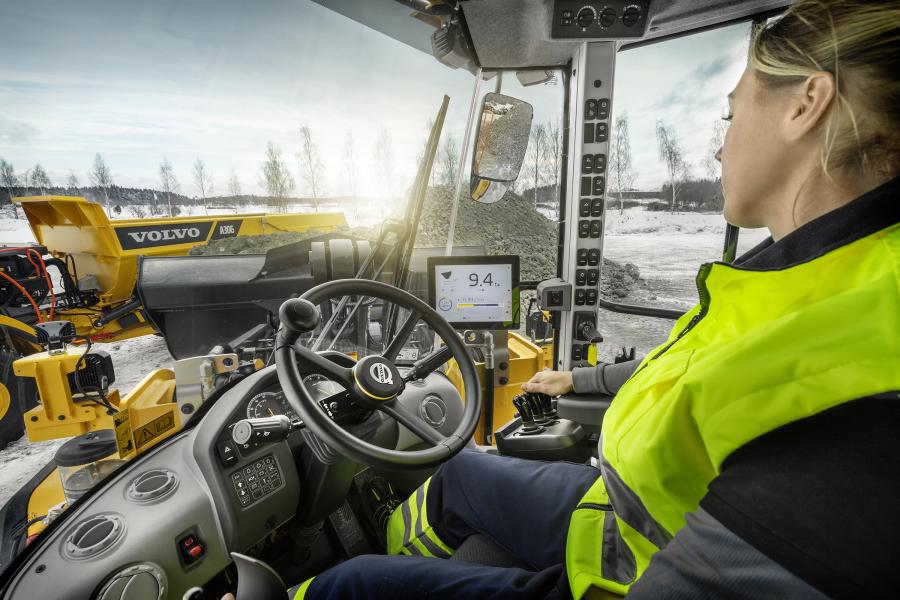
One example of telematics assisting loader operators is the data provided on bucket payload to achieve the optimal load. To that end, Volvo Construction Equipment recently updated its Load Assist OnBoard Weighing application on several of its wheel loader models, according to the company's Eric Yeomans.
“With these updates, operators are now getting real-time information on every bucket's load within plus-or-minus 1 percent accuracy, helping them reduce over-loading, under-loading, reweighing and waiting times,” explained Yeomans, a wheel loader product manager.
At Hyundai Construction Equipment, Chad Parker, a senior product specialist and sales trainer, said that just as telematics systems are used on health-monitoring devices, he predicts the same technology will be installed on wheel loaders.
“I can see additional alarms and sensors coming that will warn operators of hazardous ground conditions, such as an approaching bank or water hazard,” he forecasted. “They will become standard with a braking system to bring the machine to a stop. These sensors will also prevent wheel loader arms from moving in the event there is an on-coming object within a certain distance.”
Designs to Excite Consumers
A variety of opinions were offered on what the “next big thing” may be on wheel loaders — what technologies will excite dealers, fleet managers and operators of the equipment.
Dustin Hoogeveen, Hitachi Construction Machinery Loader America's district product support manager, predicted that 3-D aerial monitoring backup cameras, equipped with custom distance settings, a feature currently being tested, will soon be on its wheel loaders.
“Hitachi currently has loaders working in hot slag via remote control, but I can easily see redundant or repetitive operations being conducted autonomously in the future, too,” he added.
His colleague Mel Wade, an engineering manager at Hitachi, agrees that autonomous operation is just around the corner, but adds that upgrades to basic wheel loader efficiency will be the applications that will most interest people.
“The technology in transmissions is continuing to come a long way in providing smooth and reliable performance, as well as high durability,” he explained. “Across-the-board powertrain design, engineering and manufacturing have made more dependable axles, transmissions and engines. We are now seeing high-engine output and realizing increased efficiency, without compromising durability.”
Customers should also expect to see wheel loader functions that help operators achieve the correct torque in all situations, maintain a steady throttle position and reduce wheel slippage, according to Yeomans at Volvo.
Some manufacturers are also exploring the feasibility of electric-hybrid loaders.
Volvo, for example, has developed its LX1 prototype. In tests, Yeomans said it has achieved an approximately 50 percent improvement in fuel efficiency compared to its conventional front-end loaders. The advance is due to the use of a driveline consisting of electric drive motors and hydraulics, a battery energy-storage system, as well as a smaller diesel engine and new overall machine design. He also touted the LX1's significant reduction in noise pollution compared to conventional front-end loaders.
“It's important to note that the LX1 is a prototype and that we don't have any immediate plans to launch it commercially,” he added. “But, it offers a glimpse into the new technologies that we are testing.”
Loader Arms Key to Machine's Design
Loader arms are one component of the vehicle where consumers should not expect to see radical redesigns with each new model year, said Case's Stemper.
“They are part of a cohesive unit on the machine; they aren't just bolted on and ready to go to work,” he explained. “They also depend on the balance of the machine and the power under it. You can continually make the loader arms bigger, but to get a longer reach, you are going to need to keep in mind the undercarriage and the chassis.
“With loader arms, any redesign is a long, intensive process during which there may be a few years between refinements. You don't want a running design change to loader arms because it can influence so much of the design of the entire machine.”
One of the basic designs of today's loaders is in the style of their arm configuration. Well-designed loader arms allow for better weight distribution, which provides safer load carrying and prevents twisting of the arms and front chassis of the machine.
The Z-linkage configuration has established dominance because of its simplicity and digging force, while the parallel-lift style gives operators better visibility and handling finesse.
Yet another design uses a shooting boom, or telescopic arrangement, reported Tammi Snodgrass, National Marketing Manager at Takeuchi U.S.
“Using these booms on a wheel loader provides the operator with additional reach, greater dump height and the ability to stack and place materials in construction and agricultural applications,” she said.
Chang, at LiuGong North America, believes Z-linkage is a “pretty tried-and-true” loader-arm design and one that he thinks is the best for his company's machine.
“It's a proven design, accounting for about 80 to 90 percent of all the loader arms on the market,” he added.
At Hyundai, though, Parker believes the parallel-lift arms are making a comeback due to better engineering.
“Machines that use them have extreme visibility without the obstruction of a Z-linkage or torque parallel bar,” he explained. “You get the benefits of high-breakout force, maximum visibility and the ability to pick the payload level.”
Engineers at Hitachi are currently testing a boom arm on its loaders that is a combination of the two major designs.
“The PZ [parallel, Z-linkage] configuration maintains the best of both worlds: fewer parts to be maintained, greater breakout force at ground level, an ability to maintain the parallel lifting through the lift cycle,” described Wade. “In the future, the machine will sense and adjust automatically during the lift-cycle to maintain its best level-lifting capability.”
More Specialized Attachments on the Way
Wheel loader experts predict that attachments (and buckets) for the machine will continue to be refined — mostly by after-market suppliers. Those companies can concentrate on making specific wheel loader components without having to develop the entire machine. But, once they refine an attachment, the loader manufacturers then work to design their product to work better with that attachment.
As an example, the side-dump bucket evolved from a standard bucket when contractors requested a loader that could do that.
“We see attachments becoming more specialized, depending on the application, worksite environment, material, material density, operator experience and even the weather,” said Sam Shelton, Hitachi's marketing manager. “The weight of the attachment itself in some applications is significant. Customers are looking for attachments that last, don't add additional weight, are balanced and will fill quickly without resistance. This reduces cycle times, which results in increased productivity.”
 Hitachi is constantly studying bucket shape to increase the efficiency of the tool, said Wade. That includes studying ways to reduce bucket drag and ease fill, which, in turn, saves on equipment wear and tear, fuel use and overall operational expenses.
Hitachi is constantly studying bucket shape to increase the efficiency of the tool, said Wade. That includes studying ways to reduce bucket drag and ease fill, which, in turn, saves on equipment wear and tear, fuel use and overall operational expenses.
Most OEMs offer a comprehensive range of buckets and attachments designed for a specific kind of work. Applications requiring moderate breakout force are standard throughout the industry, but some companies, like Volvo, offer wheel loaders with heavy-duty, general-purpose buckets made with wear-resistant steel for performance longevity. The maker also has units with straight-edge rock buckets for loading easily broken material from banks, as well as spade-nose rock buckets for breaking out hard, stony material and shot rock.
“It's important for contractors to know that bucket volume alone is not an adequate measure of the capacity of a loader — the crucial factor is the ability of a wheel loader to fill the bucket during every pass,” said Volvo's Yeomans.
General-purpose buckets are the most common bucket-design for maximum filling and material retention on wheel loaders. The design works best in day-to-day material handling or when working in a wide range of densities such as general aggregates in construction.
“Contractors who work in rugged, difficult soil conditions may want to add rugged, ground-engaging tools to enhance the performance of their wheel loader and bucket,” explained Aaron Kleingartner, marketing manager of Doosan Infracore North America. “Many manufacturers, like Doosan, offer a vast number of interchangeable bolt-on teeth options for general purpose, light material and multi-purpose buckets. Weld-on teeth are typically offered for heavier-duty buckets, such as rock buckets, to reduce wear.”
Attachments used on loaders can range from a traditional pin-on bucket to grapples requiring extra hydraulic lines and controls.
At Komatsu, several of its loaders feature single-lever work equipment controls with an integrated auxiliary switch allowing the operator to control the attachment with his or her thumb.
“As we release new models, we are continuously updating our bucket design,” noted the company's Craig McGinnis. “The WA500-8 and WA600-8 loaders feature new buckets with improved loading performance that increased overall machine efficiency. The WA480-8, for one, sports a brand-new bucket design with generous curves on the sidewalls for better pile penetration. This design feature also improves carry performance, spilling less material while moving around the job site.”
Sprucing Up the Office
With operators having to work many hours inside the cab, just like in an office, an emphasis has lately been placed on making the experience as intuitive and comfortable as possible. This, of course, leads to better productivity and will hopefully mean reduced employee turnover for contractors.
“If the machine is too complex or the user is not really sure how to use it, they are not going to get anything out of it,” said Case's Stemper. “We want to improve the systems and how they interface more easily with the user. As the pool of trained and experienced operators seems to be getting smaller, we are trying to reduce the learning curve so that they can be productive and efficient on the machines earlier in their careers.”
Each loader manufacturer looks to improve visibility and ergonomics within the cab, while also installing automotive-style interiors with cleaner lines. Product experts see better operator visibility on the horizon to complement the lower corner and door windows already built into many loaders. Detection systems, too, are being produced that afford the cabs and platforms a 360-degree view.
 For instance, at Case, the company redesigned the cab of its full-sized G-series wheel loaders to replace a three-paned front window with a single-paned piece of glass that is almost floor-to-ceiling to improve visibility in the front. In addition, there is more glass in the back and on the sides, along with standard rear-view cameras on every model, Stemper said.
For instance, at Case, the company redesigned the cab of its full-sized G-series wheel loaders to replace a three-paned front window with a single-paned piece of glass that is almost floor-to-ceiling to improve visibility in the front. In addition, there is more glass in the back and on the sides, along with standard rear-view cameras on every model, Stemper said.
To keep worksite noise from interfering with an operator being able to concentrate on his job, the makers also are engineering better sound insulation with noise-cancelling devices.
Among the other features envisioned within a loader cab are hands-free communications and improved sensors capable of reading, analyzing and responding to changes in terrain, materials, operator behavior, etc., all without intervention from the operator.
“The science of ergonomics is constantly evolving, especially regarding operator controls,” added Wade at Hitachi. “For instance, we just updated the joystick steering to be more ergonomically-controlled. Soon, the hydraulic loader controls will be part of the seat assembly. They're consistent with the operator movement, rather than controls located on the stationary console. “
Finally, inside cab air quality is being addressed through controlled filtration, tightly-sealed cabs, and optional air-filtration systems for environmentally-challenging areas.
OEMs Utilize Customer Feedback
Every design improvement on wheel loaders is heavily influenced by what the manufacturers call “Voice of Customer,” or VOC for short.
Doosan, for instance, regularly works with its customers and dealers to gather feedback about its products and uses the data to enhance and improve its products. Input gathered from the VOC process has led to enhancements in Doosan wheel loader iterations that have produced new developments in productivity, performance, operator comfort, visibility and fuel efficiency, according to the company's Kleingartner.
“VOC is probably the most important feedback we get,” said Case's Stemper. “Engineers tend to think of these products differently than customers. At our company, we concentrate on customers' needs and making an evaluation on what they are asking for. But, we also try to understand what they are implying in what they are asking. It is not only the specific words that are being said, but how they are being said and the context of when they are said that gives us the most insight about their needs.
“Part of that process is also driving to where they are using the equipment and observe them doing so while trying to understand the nuances of their feedback.”
CEG
Today's top stories



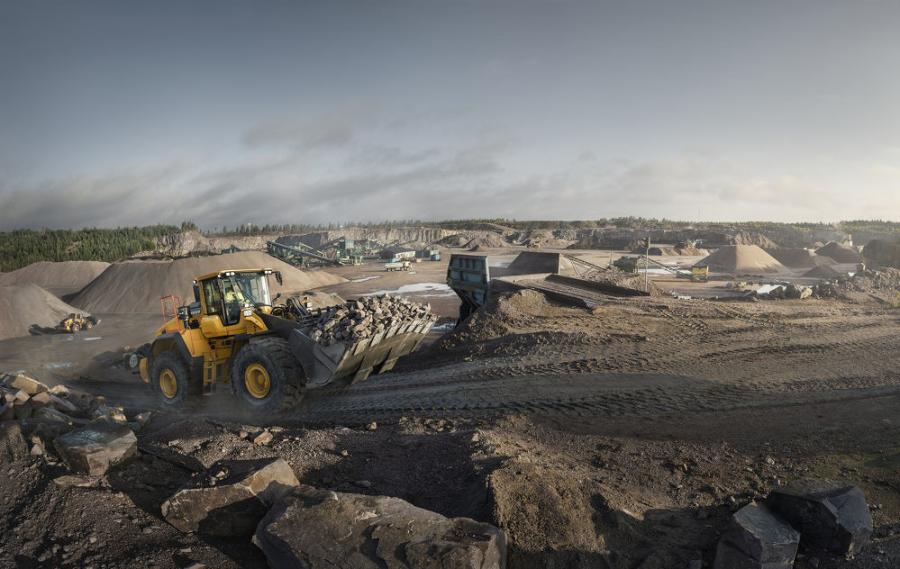






 Hitachi is constantly studying bucket shape to increase the efficiency of the tool, said Wade. That includes studying ways to reduce bucket drag and ease fill, which, in turn, saves on equipment wear and tear, fuel use and overall operational expenses.
Hitachi is constantly studying bucket shape to increase the efficiency of the tool, said Wade. That includes studying ways to reduce bucket drag and ease fill, which, in turn, saves on equipment wear and tear, fuel use and overall operational expenses. For instance, at Case, the company redesigned the cab of its full-sized G-series wheel loaders to replace a three-paned front window with a single-paned piece of glass that is almost floor-to-ceiling to improve visibility in the front. In addition, there is more glass in the back and on the sides, along with standard rear-view cameras on every model, Stemper said.
For instance, at Case, the company redesigned the cab of its full-sized G-series wheel loaders to replace a three-paned front window with a single-paned piece of glass that is almost floor-to-ceiling to improve visibility in the front. In addition, there is more glass in the back and on the sides, along with standard rear-view cameras on every model, Stemper said.

